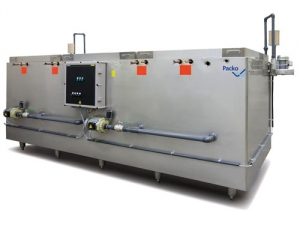Farmers planning to meet new milk cooling regulations from 2017 are offered a new means of doing so.
The Packo Ice Builder, used on European dairy farms for 50 years, is now sold here. Two machines are on trials on two farms, and several have been sold, says the distributor Dairy Cooling Solutions, a division of Eurotec.
Sales and marketing director Chris Farmer says Packo is considered a pioneer in milk cooling and is the world’s oldest milk cooling tank maker. Units have been sold for over 20 years in Australia; and more than 1500 operate there.
New Zealand milk is highly regarded for its quality and safety, despite our temperature rules for raw milk being less stringent than our major trading partners.
In NZ milk temperature must drop to 7˚C within three hours of milking and remain at 7˚C until collection, similar to the US. In China it must get to 4˚C within two hours of milking, and the same in Russia. In Australia milk temperature must be 5˚C within 3.5 hours of starting milking. In the EU, 8˚C after milking and 6˚C degrees if not collected daily.
The new MPI regulations require farmers to hold milk at 6oC or cooler until the tanker collects. The new rule takes effect from mid 2016 for new farm dairies and mid 2017 for existing dairies.
Farmer says Dairy Cooling Solutions will sell the Packo Ice Builders via contractors, ensuring full back-up service.
He says a one-size-fits-all approach will not work for milk cooling.
“Each farm is different, with different herd sizes and different energy consumption, some have pre-cooling whilst others don’t. We will talk to farmers and contractors and engineer solutions to fit each farm.”
The Packo Ice Builder is claimed perfect for farms where access to water for pre-cooling is a problem; it is possible to cool all the milk without any bore water.
”It has a large instant cooling capacity: ice is melted down at the moment of use. It has maximum cooling speed, there is no risk of product freezing and most importantly it saves energy, reduces peak demand and shifts energy consumption.”
How the Packo works
The Packo Ice Builder builds up an ice reserve during off-peak production periods with which it can cool a large amount of ice water to zero degrees.
The unit is made of stainless steel plate (AISI 304). Foam insulation 50mm thick is injected between the interior and exterior housing.
Ice water runs through a plate heat exchanger for snap chilling, or the heat exchanger in the PACKO DIB tank if an Ice Water Milk Cooling Tank is integrated (this provides the most efficient cooling solution). Rapid cooling, without the risk of freezing, is ensured.
Options include an extra ice water pump(s) for instant cooling and a time clock for the use of cheaper night-rate electricity.
A unit can be integrated into an existing cooling system, or can be offered as part of a new system.


















